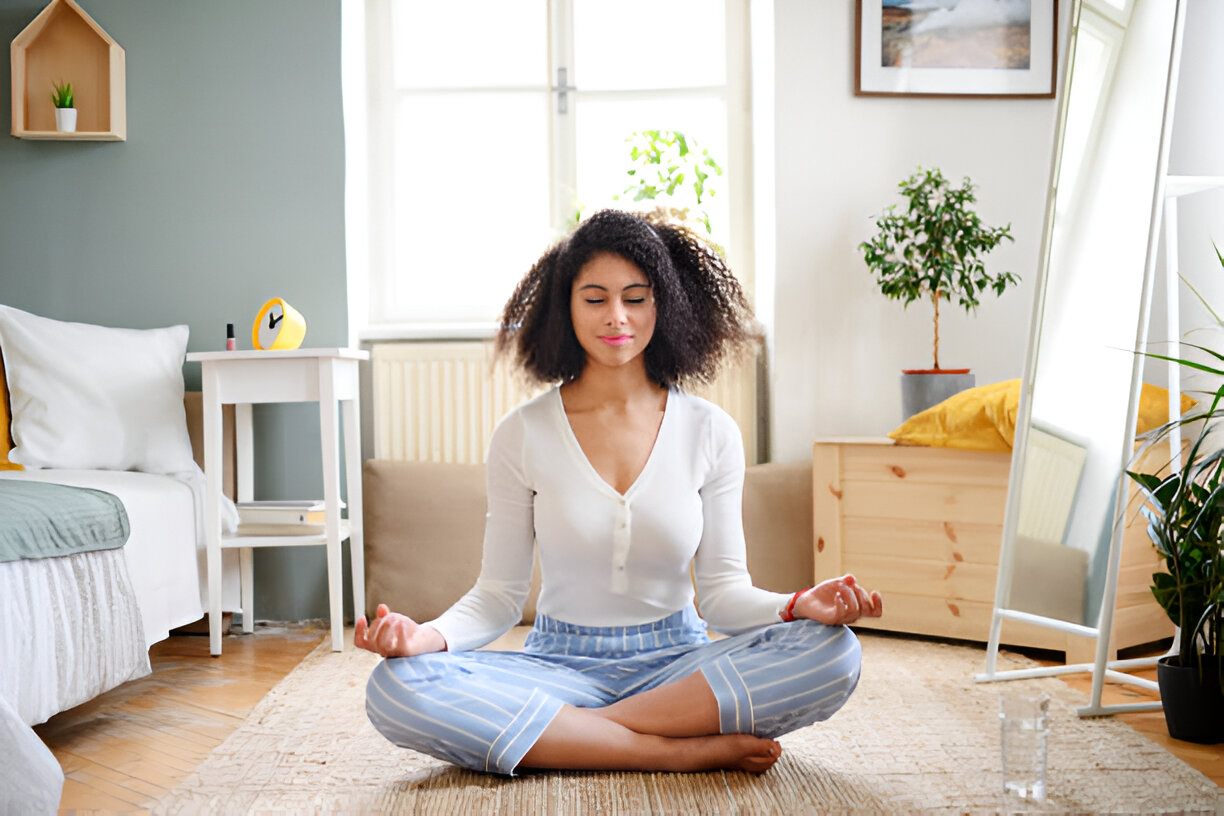A morning yoga practice can help you start your day feeling energized, focused, and balanced. This beginner-friendly routine uses simple poses and gentle movements that anyone can do, even if you've never tried yoga before.
What You'll Need
- A yoga mat or non-slip surface
- Comfortable, stretchy clothing
- Optional: A yoga block or thick book for support
- Optional: A blanket for comfort
Before You Begin
- Practice on an empty stomach or at least 2 hours after eating
- Move slowly and breathe deeply
- Never force yourself into painful positions
- Listen to your body and modify poses as needed
Warm-Up (5 minutes)
Seated Breathing
Start by sitting comfortably cross-legged on your mat. Close your eyes and take 5-10 deep breaths, feeling your chest and belly expand with each inhale. This helps calm your mind and prepare your body for movement.
Neck Rolls
Gently drop your chin to your chest and roll your head in slow circles, first clockwise then counterclockwise. This releases tension in your neck and shoulders from sleep.
Shoulder Rolls
Roll your shoulders forward and backward several times, making big circles. This wakes up your upper body and improves posture.
Main Sequence (20 minutes)
Child's Pose
Start on your hands and knees, then sit back onto your heels with arms stretched forward. This gentle stretch releases your back and helps you feel grounded. Hold for 1-2 minutes while breathing deeply.
Cat-Cow Stretch
Return to hands and knees. As you inhale, lift your chest and tailbone (Cow pose). As you exhale, round your spine like a cat. Repeat 8-10 times, moving with your breath.
Downward-Facing Dog
From hands and knees, tuck your toes and lift your hips toward the ceiling, forming an inverted V-shape. Keep your knees slightly bent if needed. Hold for 5-8 breaths, pedaling your legs to warm up your calves.
Standing Forward Fold
Walk to the front of your mat. Stand tall, then bend forward from your hips, letting your head and arms hang heavy. Bend your knees as much as needed to feel comfortable.
Mountain Pose
Stand tall with feet hip-width apart. Roll your shoulders back, lengthen your spine, and feel grounded through your feet. Take 3-5 deep breaths here.
Warrior I
Step your right foot back and bend your left knee. Lift your arms overhead. Keep your front knee aligned with your ankle. Hold for 5 breaths, then switch sides.
Tree Pose
Stand on your right leg and place your left foot against your right inner thigh or calf (not on the knee). Hold for 5 breaths, then switch sides. Use a wall for balance if needed.
Bridge Pose
Lie on your back with knees bent and feet flat. Lift your hips toward the ceiling, keeping your shoulders on the mat. Hold for 5-8 breaths.
Knees-to-Chest
Hug both knees into your chest, gently rocking side to side to massage your lower back.
Supine Twist
Extend your right leg and hug your left knee. Gently guide your left knee across your body for a gentle spinal twist. Hold for 5 breaths, then switch sides.
Cool-Down (5 minutes)
Happy Baby Pose
Lie on your back and hold the outer edges of your feet, knees bent toward armpits. Gently rock side to side, releasing tension in your hips and lower back.
Legs Up the Wall (or in the Air)
Lie on your back and extend your legs toward the ceiling, keeping them straight or slightly bent. This pose helps reduce swelling and fatigue in your legs.
Final Relaxation
Lie flat on your back in Savasana (Corpse Pose). Let your arms and legs relax completely. Close your eyes and breathe naturally for 2-3 minutes.
Tips for Success
Breathing Basics
- Always breathe through your nose unless instructed otherwise
- Make your inhales and exhales slow and steady
- Try to match the length of your inhales and exhales
- If you feel short of breath, take a break or modify the pose
Common Mistakes to Avoid
- Don't rush through poses
- Avoid jerky or forced movements
- Don't compare yourself to others or pictures
- Never push through pain
Signs You Should Take a Break
- Feeling dizzy or lightheaded
- Sharp or shooting pain
- Difficulty breathing
- Extreme fatigue
Making This Routine Work for You
Modifications for Limited Flexibility
- Use yoga blocks or books for support
- Keep knees bent in forward folds
- Reduce the depth of stretches
- Use a wall for balance when needed
Building a Consistent Practice
- Try to practice at the same time each day
- Start with 2-3 sessions per week
- Be patient with your progress
- Celebrate small improvements
When to Skip or Modify
- During illness or fever
- If you're extremely tired
- When experiencing unusual pain
- During acute injuries
Benefits You'll Notice
Physical Benefits
- Improved flexibility and balance
- Better posture
- Reduced morning stiffness
- Increased energy levels
Mental Benefits
- Clearer thinking
- Reduced stress
- Better focus throughout the day
- Improved mood
Moving Forward
As you become more comfortable with these poses, you can:
- Hold poses for longer periods
- Add more challenging variations
- Increase practice frequency
- Explore new poses and sequences
Remember that yoga is a personal journey. Some days will feel easier than others, and that's completely normal. Focus on how the poses feel rather than how they look, and always prioritize steady breathing over perfect form. With regular practice, you'll notice improvements in both your physical abilities and mental clarity.
This routine is meant to be a foundation that you can build upon. As you gain confidence and body awareness, you can adjust the sequence to better suit your needs and schedule. The most important thing is to maintain a consistent, mindful practice that makes you feel good and energized for the day ahead.
Latest Blog
How to Recognize and Break Free from a Toxic Relationship
Toxic relationships are more common than we’d like to admit. They can creep into our lives disguised as l...
Why Do I Always Attract Toxic Partners?
Have you ever wondered why you keep ending up with partners who drain your energy, hurt your feelings, or make you question your worth? You're not alone. Many people find themselves caught in a cycle of toxic relationships, feeling frustrated and confused about why it keeps happening.Early Life Experiences Shape Our Relationship PatternsThe way we learned about love and relationships in childhood often sets the...
Major Concerns Facing Working Women Today
The Challenge of Work-Life BalanceWorking women often struggle to balance their professional and personal lives. Many feel pulled in different directions, trying to excel at work while managing household responsibilities. This includes taking care of children, doing household chores, and looking after elderly family members. The pressure to "do it all" can lead to stress and burnout.Women often work a "second s...


.jpg)








